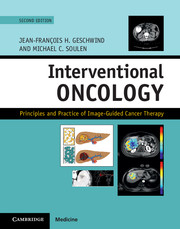Book contents
- Frontmatter
- Contents
- List of contributors
- Section I Principles of oncology
- Section II Principles of image-guided therapies
- Section III Organ-specific cancers – primary liver cancers
- Section IV Organ-specific cancers – liver metastases
- Section V Organ-specific cancers – extrahepatic biliary cancer
- Section VI Organ-specific cancers – renal cell carcinoma
- Section VII Organ-specific cancers – chest
- Section VIII Organ-specific cancers – musculoskeletal
- Section IX Organ-specific cancers – prostate
- Section X Specialized interventional techniques in cancer care
- 28 Vascular access: Venous and arterial ports
- 29 Palliative care and symptom management
- 30 CT-guided neurolysis for cancer-related abdominal and pelvic pain
- 31 Palliative procedures for ascites and effusion
- Index
- References
28 - Vascular access: Venous and arterial ports
from Section X - Specialized interventional techniques in cancer care
Published online by Cambridge University Press: 05 September 2016
- Frontmatter
- Contents
- List of contributors
- Section I Principles of oncology
- Section II Principles of image-guided therapies
- Section III Organ-specific cancers – primary liver cancers
- Section IV Organ-specific cancers – liver metastases
- Section V Organ-specific cancers – extrahepatic biliary cancer
- Section VI Organ-specific cancers – renal cell carcinoma
- Section VII Organ-specific cancers – chest
- Section VIII Organ-specific cancers – musculoskeletal
- Section IX Organ-specific cancers – prostate
- Section X Specialized interventional techniques in cancer care
- 28 Vascular access: Venous and arterial ports
- 29 Palliative care and symptom management
- 30 CT-guided neurolysis for cancer-related abdominal and pelvic pain
- 31 Palliative procedures for ascites and effusion
- Index
- References
Summary
Hepatic intra-arterial port
Indications
Because hepatic artery infusion chemotherapy (HAIC) is a local treatment, it is most often used in case of liver cancer without extrahepatic disease, or in patients with predominant hepatic disease. Such treatment has been used mostly as salvage therapies after failure of intravenous (IV) standard-of-care therapies for metastases, and because response rate remains interesting even when using the same drug that was or became inefficient with IV administration. Due to the high response rate of HAIC, there are some recent reports and ongoing study using such therapies in first line. The goal of such therapies in first line, as a so-called induction treatment, is to obtain as early as possible in the disease the highest response possible in order to downstage a non-surgical candidate to a surgical candidate. Indeed, it has been demonstrated that the increase in response rate of colorectal liver-only metastases (CRLM) to treatment is linearly correlated with an increase in resection rate, and consequently with an increased chance of cure. Such induction chemotherapy targeting specifically the liver is obviously even more interesting in patients with liver-limited disease which demonstrated a steeper slope of the linear correlation between response and downstaging from non-operable to surgical candidates. HAIC used in an adjuvant setting after liver resection has been demonstrated to increase survival.
For primary tumors, and namely hepatocellular carcinoma, the use of HAIC is less common due to the high efficacy of transarterial chemoembolization (TACE). Indications are probably in patients not responding to TACE or not candidates for TACE due to portal vein thrombosis or advanced liver insufficiency.
HAIC is technically more challenging than systemic chemotherapy, because it requires the implantation of an indwelling catheter in the hepatic artery that is connected to a subcutaneous port for the administration of repeated courses of HAIC. The main drawbacks that hampered the use of HAIC were that, until recently, the implantation of such a device required a laparotomy, and additionally, frequent catheter dysfunction led to discontinued treatment. For example, in a randomized controlled study comparing HAIC with 5-fluorouracil (5-FU) to systemic 5-FU in 290 cases, 50 (37%) patients allocated to HAIC did not start their treatment, and another 39 (29%) had to stop before receiving six cycles of treatment because of catheter failure. Only 33% of patients received at least six courses of HAIC vs. 78% for the IV route.
- Type
- Chapter
- Information
- Interventional OncologyPrinciples and Practice of Image-Guided Cancer Therapy, pp. 283 - 293Publisher: Cambridge University PressPrint publication year: 2016



